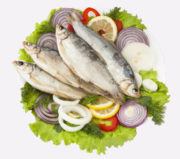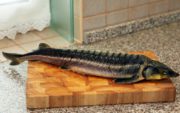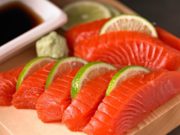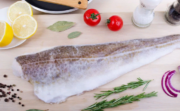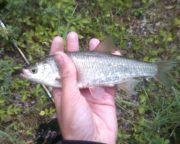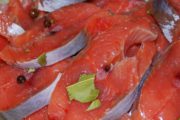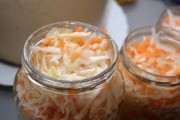Lightly salted salmon - two simple salting recipes
Salmon is a natural antidepressant, lowers blood sugar and improves metabolism. People with weakened immune systems and children are highly recommended to introduce salmon into their diet. Of course, for a product to be beneficial, it must be a properly prepared product. Lightly salted salmon, prepared with your own hands, is an ideal way to preserve all the nutrients that will improve your health and simply delight you with its taste.
For the best taste, be sure to choose fresh, medium-sized fish. Salmon that is too small has a lot of bones and is very difficult to handle. Too big is also not very suitable for these purposes. Adult salmon meat will be somewhat tough, and not everyone will like it. The ideal weight of salmon for salting is approximately 2-3 kg.
Dry salted salmon
Wash the fish and remove scales. Remove tail, head and gut. Some advise cutting out the fins, but this is not for everyone. They do not interfere with salting, and they contain the lion's share of fish oil.
Cut the salmon carcass along the spine and remove the spine.
There is no need to remove the skin from the salmon; this can be done later, after salting.
Mix in a plate:
- 2 tbsp. l. coarse (non-iodized) salt;
- 1 tsp. Sahara;
- 5 clove buds;
- 10 black peppercorns;
- 2 laurel leaves.
(The last three spices need to be ground in a mortar)
In fact, all these proportions are quite arbitrary. There are ready-made spices for salting fish that you can use, or come up with your own composition based on your own taste.
Cut the fish carcass into manageable pieces. Roll each piece in a mixture of salt and spices, and place in a deep (not metal) bowl.
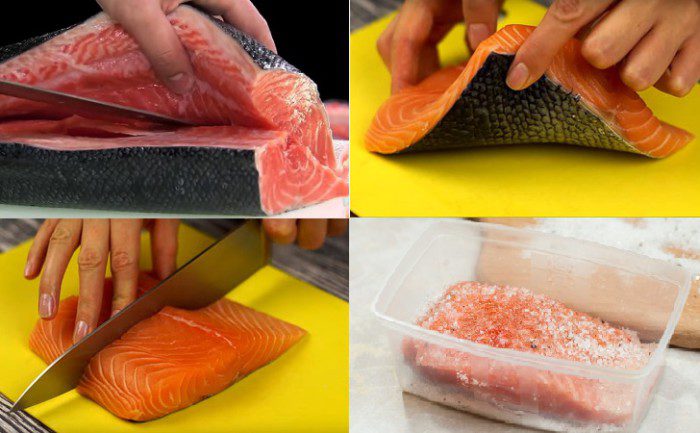
Cover the bowl with a lid and just leave it on the kitchen counter to salt for 2-3 hours.
After this, place the fish bowl in the refrigerator for another 10-12 hours. This time is enough for the salmon to be salted and ready for consumption.

Lightly salted salmon in brine
Some types of salmon are too dry and when salted the meat becomes too dense. This kind of fish will work for sandwiches, but it will look rough in a salad. To make soft fish, it is salted in brine.
Process the fish as in the previous recipe and place it in a bottle or saucepan.
Prepare the marinade in a separate pan.
- For 1 liter of water take:
- 2 tbsp. l. salt (heaped).
- 1 tbsp. l. Sahara;
- spices (at your discretion).
- 2 tbsp. l. vegetable oil;
- 2 tbsp. l. vodka, or the same amount of lemon juice.
The last 2 points may raise questions. Vegetable oil makes up for the lack of fat in the meat and makes it a little softer. Vodka or lemon juice disinfects fish from parasites, which river fish are rich in. And of course, they also help the salmon salt faster.
So, pour water into the saucepan and add all the ingredients according to the list. Bring the brine to a boil and immediately turn off the heat.
Cover the saucepan with a lid and let it cool on its own. You can fill the fish with only slightly warm brine, but not hot.The brine should completely cover the fish, and if you don’t have enough, just add boiled water from the kettle.
Leave the salmon to brine in the brine at room temperature for 3-4 hours, after which put the container with the fish in the refrigerator for another 10 hours.
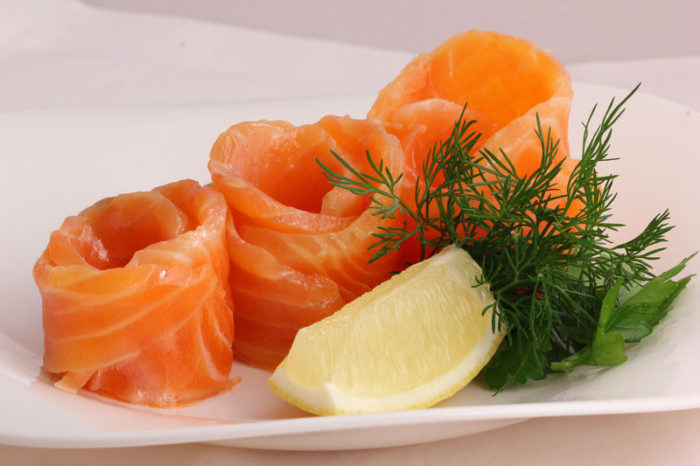
Before eating, remove the salmon pieces from the brine and let them drain on a wire rack. You can dry them a little with a paper towel and try how different salmon in brine is from dry-salted salmon. In fact, both methods are good, and be sure to try them.
How to salt salmon so that it can be stored for a very long time, watch the video:



